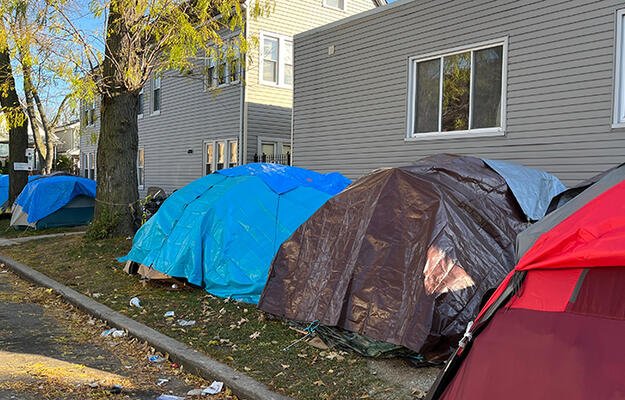
Why Domestic Violence Organizations Are Core Partners for Housing Providers
by Veronica Gaitán
According to the National Coalition Against Domestic Violence, one in three women and one in four men have experienced physical violence by a partner. Survivors of domestic violence sometimes have to choose between staying in a home that is unsafe or not having a home at all. During the national homelessness count in January 2017, 87,329 people—or 16 percent of the homeless population—reported having experienced domestic violence. Between 22 and 57 percent of homeless women report that domestic violence was the immediate cause of their homelessness. Housing providers can open the door out of domestic violence, improving the well-being of survivors and their families.
Shelter and transitional housing are the most requested services by domestic violence survivors but are the least available for them. Shelters across the country are overcrowded, and the nation’s affordable housing stock is diminishing. A 2016 study found that, in a single day, US domestic violence programs fielded more than 20,000 hotline calls, but nearly 12,000 requests for help went unheeded because the services weren’t available. Two-thirds of the unmet requests for services were for housing.
While this shows the need for expanded housing resources (and relationships between homeless service systems and domestic violence hotlines), the role of housing in escaping domestic violence does not end with a new set of keys. Once survivors have secured shelter, they may need additional services to access or maintain permanent housing, including trauma counseling, legal services, and financial advising. Cross-sector partnerships between housing providers, domestic violence organizations, policymakers, and other service providers can help domestic violence survivors flee, achieve residential stability, and work toward recovery.
Here are three ways housing organizations can be part of the solution for domestic violence.
- Continuums of Care should embed coordination with domestic violence service providers throughout the annual point-in-time homelessness count.
The US Department of Housing and Urban Development’s (HUD’s) Continuum of Care (CoC) program provides funding for nonprofit organizations and state and local governments to address and reduce homelessness. Continuums of Care also document the number of people living in homeless shelters and on the streets (or other places not meant as housing) for the annual point-in-time homelessness count nationwide. Continuums of Care are encouraged, but not required, to partner with domestic violence service providers for the point-in-time count. Such partnerships could help identify this subset of the homeless population and ensure these people receive appropriate, targeted supports.
For the 2018 count, advocates lobbying for survivors succeeded in changing the interview language to improve communities’ awareness of domestic violence as a contributor to their homelessness count. Previously, communities were only recommended to ask homeless people whether they had experienced domestic violence. A new question asks whether they are homeless because of domestic violence, sexual assault, dating violence, or stalking. “Clarifying the problem as much as possible can lead to better solutions,” said Courtney Morton, the housing and research coordinator for Community Support Services of Mecklenburg County, North Carolina.
Engaging domestic violence service providers in the annual homelessness count is a small but achievable and effective step for CoCs to take. Additional efforts include partnering with domestic violence organizations for coordinated entry, ensuring that confidential emergency shelter locations are always available, educating housing providers on protections for survivors, and so much more.
- Affordable housing providers should partner with domestic violence service providers to identify and refer survivors.
In 2013, the reauthorization of the Violence Against Women Act expanded housing protections for survivors of domestic violence to all federally subsidized housing programs, made it illegal for public housing authorities (PHAs) to evict someone from public housing or terminate their housing voucher because they have experienced domestic violence, and allowed PHAs to establish waiting list preferences for survivors and their families. But with limited units and limited assistance available, HUD encourages PHAs to work with community partners to recognize and respond to domestic violence situations for assisted families. HUD recommends that PHAs invite advocates for domestic violence survivors to speak to employees and governing boards, provide accessible information pamphlets, facilitate counseling in available community space, and prioritize survivors referred through the local CoC. Public housing authorities need to develop innovative strategies to work with their often-limited resources and capacities to make these solutions a reality.
Other affordable housing providers should assess their processes to find similar opportunities to better serve survivors. This could be facilitated through clarifying and training service providers to identify domestic violence risks, communicating with residents in ways that protect privacy, and instituting mechanisms for collecting and reviewing feedback from residents, among other strategies.
- Housing providers, funders, policymakers, and advocates in communities should seek additional opportunities for alignment with domestic violence service providers.
Partnerships that develop common goals and prioritize collective action to achieve them can help communities become the strongest advocates for residents who have experienced domestic violence. Successful community partnerships may involve advocates from both the housing and domestic violence spaces, private landlords, public housing authorities, funders, national organizations, and others.
Keys to a successful partnership include
- regular alignment of goals;
- joint identification of barriers to success;
- a clear prescription of specific roles of each player involved; and
- a firm understanding of each partner’s ethical obligations.
The District Alliance for Safe Housing (DASH), which is based on a model that can be incorporated into any housing program that provides services to survivors, is a strong example of such a partnership. It has a clearly identified strategy equipped to assist survivors at every stage, from providing emergency housing and financial assistance, to providing transitional housing for survivors and their families, to facilitating access for survivors to obtain permanent, safe housing. In addition, DASH has conducted evaluations of its impact and provides training and technical assistance to community-based organizations.
Beyond Partnerships
Community-level partnerships are only part of the recipe for housing organizations seeking to support survivors of domestic violence. An adequate housing supply is the most basic ingredient to enable domestic violence survivors to escape—and to do so without becoming homeless. Housing policies can make it easier or harder for survivors to escape while rebuilding stability. For example, nuisance laws can contribute to evictions of renters with frequent police calls to their home, even if those calls were for self-protection. Updated research and resources—built with an awareness of the specific concerns of domestic violence organizations—can clarify the scope of the problem and evidence base for solutions. Finally, federal resources and state and local government supports all play a vital role in ensuring that emergency shelter (or permanent affordable housing) and resident supports are funded and available.


